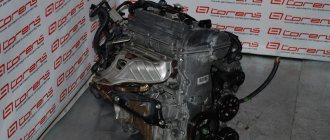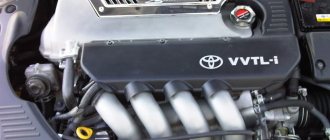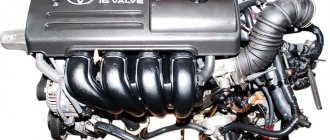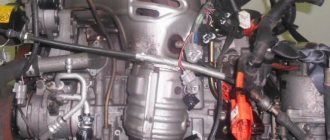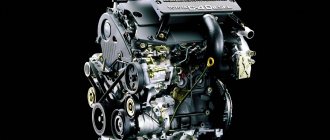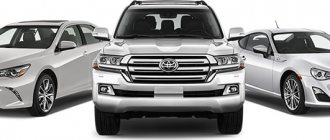Toyota Corolla engines have been considered reliable and unpretentious since 1993. The Japanese know how to create designs that, with a small volume, have high power, while boasting minimal consumption. These are technically advanced and practical units with a long service life.
The Toyota Corolla 1.6 1ZR FE engine can be called the most popular and successful. This engine contains 4 cylinders, 16 valves, and a timing chain drive, which virtually eliminates problems with it. It will pass the first 200 thousand without any intervention, the main thing is to ensure that the oil consumption is not too high, change fluids on time (preferably after 10–15 thousand mileage) and fill in high-quality fuel, since the 1.6 1ZR FE engine is quite sensitive to impurities in gasoline.
Technical characteristics of the 1ZR FE engine
| Production | Toyota Motor Manufacturing West Virginia Shimoyama Plant |
| Engine make | Toyota 1ZR |
| Years of manufacture | 2007-present day |
| Cylinder block material | aluminum |
| Supply system | injector |
| Type | in-line |
| Number of cylinders | 4 |
| Valves per cylinder | 4 |
| Piston stroke, mm | 78.5 |
| Cylinder diameter, mm | 80.5 |
| Compression ratio | 10.2 10.7 |
| Engine capacity, cc | 1598 |
| Engine power, hp/rpm | 126/6000 134/6400 |
| Torque, Nm/rpm | 157/5200 160/4400 |
| Fuel | 95 |
| Environmental standards | Euro 5 |
| Engine weight, kg | — |
| Fuel consumption, l/100 km (for Corolla E140) - city - highway - mixed. | 8.9 5.8 6.9 |
| Oil consumption, g/1000 km | up to 1000 |
| Engine oil | 0W-20 5W-20 5W-30 10W-30 |
| How much oil is in the engine | 4.7 |
| Oil change carried out, km | 10000 (better 5000) |
| Engine operating temperature, degrees. | — |
| Engine life, thousand km - according to the plant - in practice | n.d. 250-300 |
| Tuning - potential - without loss of resource | 200+ n.a. |
| The engine was installed | Toyota Avensis Toyota Corolla Toyota Auris Toyota Verso Lotus Elise |
Toyota Corolla 1.6 engine device, timing, characteristics
Reading time: 1 minute
Toyota Corolla engines , which are installed on Russian versions of the Toyota Corolla sedan, are very interesting. Firstly, they are all gasoline and are of the same design. These are in-line 4-cylinder, 16-valve units with an aluminum cylinder block and timing chain ! In addition, the design uses a double variable valve timing system VVT-i. Which makes the performance of Corolla engines quite good. The main advantage is, of course, real efficiency with good dynamics. In addition to the chain drive in the timing belt of the 11th generation Corolla engines, there are also hydraulic compensators in the cylinder head, which deprives you of the “pleasure” of adjusting the valves manually. Among the shortcomings, we can note the poor maintainability of these power units. The manufacturer simply forgot about the repair dimensions. In fact, full-scale production of power units has been established in China at the FAW plant. The power units get under the hood in Turkey, and from there the finished cars are transported to the Russian market.
Below are detailed technical characteristics of each Corolla engine.
Story
The Toyota Corolla car dates back to 1966. The engine then was 1.4-liter, its reliability deserved praise. The first injector was installed on the Corolla in 1979. By that time, there were already two engine options: 1.4 and 1.6 liters.
The first diesel engine in the Toyota Corolla appeared in 1983 (1.8 liters).
The engine life of the first Toyota engines was quite large.
Modern engines appeared in 2008 and have lost this quality of their predecessors.
conclusions
If you are faced with the question of choosing a power plant when purchasing a Toyota Corolla, then you should weigh several factors at once: dynamics, efficiency, maintenance cost and reliability. A compromise option will be the 1ZR-FE engine with a displacement of 1.6 liters. Its fuel consumption will allow you to save at gas stations, the dynamics will be acceptable for city and rare country driving, and its service life is more than 400,000 kilometers. If you need better dynamics, you should pay attention to the 2ZR-FE, and the 1NR-FE will appeal to lovers of measured city driving. It is better to refuse to buy a car with a ZZ series engine.
Flaws
Modern Corolla engines are characterized by the following disadvantages:
- High oil consumption. The problem is related to the occurrence of oil scraper rings. The problem was resolved in 2005. Owners of 2008 1.6 cars note that the problem is much less common.
- Increased engine noise, knocking. The timing chain of Toyota engines stretches quite quickly and begins to make extraneous noise.
- Floating engine speed. If this problem occurs, it is recommended to clean the throttle valve.
- Engine vibration. This characteristic is often found and is considered the norm for Toyota Corolla. If vibration increases, it is necessary to check the rear engine mount.
Owner reviews about the resource
Of course, what kind of resource your car’s engine will have depends on how you treat the car and operating conditions. Nevertheless, general trends can still be traced. Toyota Corolla engines do not receive positive reviews in terms of longevity. In most cases, they require replacement after 200,000 km.
You can often see on forums that the Corolla engine is called “disposable”. This characteristic is not far from the truth: the fact is that Toyota aluminum units are officially not subject to major repairs. Of course, you can carry out some manipulations with them to extend their service life, some car services even offer similar services, but such actions cannot be called full-fledged capital.
Engines after 2005 are considered more reliable than units from the beginning of the 21st century, but the opinion about them in the automotive community is still ambiguous.
Technical data
The Toyota Corolla 1ZR FE internal combustion engine is distinguished by the following characteristics:
- Engine volume – 1.6 liters.
- 4 cylinders, power – 122 hp. With.
- Acceleration to hundreds is carried out in 10.5 seconds.
The engine is powered by AI 95, consumption on the highway is 5.5 liters, the combined cycle is one liter more, in the city - about 9-10 liters. The working life is 400 thousand km. A special feature is the absence of repair dimensions for cylinders. In addition, the engine suffers greatly from overheating. Such engines were installed in almost all cars produced before 2008.
Reviews
Sergey, driving experience - 3 years
I got the Corolla from my dad, as a poor student. What was gone is gone. But I'm not complaining. Although the engine cannot boast of sportiness. It’s especially noticeable on the highway; if you want to overtake, you need to downshift to get the required speed.
Ivan, driving experience – 7 years
When the choice arose about which car to buy, I decided to read the reviews first and chose the 2003 Toyota Corolla 1.4 liter. Why? Yes, because I didn’t intend to participate in super races, but wanted to buy something economical and not go beyond the budget (550,000 rubles). I drive it only on weekends, on weekdays I work, and it’s two steps to work. So far the engine has not had any malfunctions, everything is ok, it has only undergone one maintenance, everything is fine, and it was inexpensive. I'm happy with the car.
Sergey, driving experience – 25 years
I have a 2008 Corolla with a 1.4 liter engine. And although the characteristics of this unit are not replete with a large number of positive reviews, it is optimal for those who love a calm and confident ride. And in combination with low fuel consumption, this is what a driver like me needs (we mostly go to the country on weekends).
Kirill, driving experience – 17 years
I was choosing between a Honda Civic and a Corolla, but in the end my wife decided on the latter option. Now I'm glad I agreed. The dynamics are excellent, the consumption is low, and it doesn’t break through on potholes and ruts. Even in severe frosts (-40°C) it started perfectly without problems.
"Corolla" 1.6
This is the most popular version of the Corolla in Russia. It is equipped with a four-speed automatic transmission. As for the engine itself, its power is 124 horsepower.
The unit has more decent technical characteristics. Toyota Corolla (2008) with a 1.6 engine accelerates to hundreds in 11 and a half seconds (despite the fact that the curb weight of the car is 1300 kilograms).
The engine torque is 157 Nm. It is available at 5.2 thousand rpm. Fuel consumption is not much different from the previous unit - up to 7 liters per 100 kilometers.
We also note that version 1.6 was released on mechanics. In this case, the car reached a hundred a second earlier. The maximum speed on the automatic is 183 kilometers per hour. On mechanics - up to 192.
Malfunctions, problems and their causes
1
.
High oil consumption. The problem is typical for the first ZR models, it is solved by pouring oil with a viscosity of W30, instead of 0W-20, 5W-20. If the mileage is serious, then measure the compression. 2
.
1ZR engine knocking. Noise at mid speed? Change the timing chain tensioner. In addition, the generator drive belt may also make noise (whistle), so replace it. 3
. Problems with idle speed. Swimming and other troubles are caused by the throttle position sensor and a dirty throttle body itself. In addition, the pump on the 1ZR likes to leak, make noise and ask to be scrapped after 50-70 thousand km, the thermostat often dies and the engine refuses to warm up to operating temperature, the VVTi valve can jam with subsequent dullness of the car and loss of power. However, these problems do not occur all the time; the 1ZR engine turned out to be quite good, with a normal service life (+\- 250 thousand km) and with stable maintenance, it does not cause problems for the owner.
Owner reviews
- Valentin, Chelyabinsk. I own a 2008 Toyota Corolla with a 1.6 engine and a manual transmission. The mileage is 300,000 km, taking into account the difficult climatic conditions, I think that this is an excellent indicator of the durability and stability of the engine. The engine runs stably, the speed does not fluctuate, and it does not “eat” oil. All the time I poured motor oil in an iron can with a blue label 0W20, I recently switched to 5W20, and I don’t regret it at all. Gasoline is only AI-95 "Lukoil", the dynamics, as before, are at a high level.
- Egor, Chita. At one time I drove a Corolla with a 1ZR-EE engine. I drove 350,000 km without any problems and decided to get a new generation sedan. I can say with confidence that the engine of my previous car will last just as long if it receives the proper attention. It doesn’t “eat” oil, fuel consumption is always normal, and the engine has virtually no weak points.
- Kirill, Moscow. At one time I also wondered what the lifespan of Corolla engines was under moderate use. I read a lot, looked for information on the Internet, saw various reviews and opinions. Ultimately, I decided and purchased a Toyota Corolla with a 1.6 liter engine paired with a manual transmission. I drove it more than three hundred thousand kilometers, there is a slight vibration at idle, you need to look at the engine mount. Fuel and oil consumption is normal, I don’t add more. On average, 1 liter of lubricant is used per 10 km, taking into account the leaking front oil seal (there is no time to replace it). Fuel 8 liters AI-92. I changed the timing chain twice and that's it.
- Anton, Voronezh. I own a Toyota Corolla 1.6 with a 3ZZ-FE engine. Before the purchase, I was assured that the real resource of the power unit is 250 thousand kilometers. From my own experience I was convinced that it is possible to travel 300,000 km. They say that during this time the cylinder walls suffer greatly; in fact, the Korolev engines do not lend themselves to capital. But in reality, everything is much more reliable and optimistic. It depends on how you drive and what you put in the engine.
Toyota Carina with which engine is better to choose
Specifications
The production of 4a-fe engines began in 1989 and continued until 1998. We started designing this model 10 years before its release. The purpose of creating such an internal combustion engine was to equip the Toyota Tercel car with a new engine with high performance and low fuel consumption. The main technical characteristics of 4a-fe are as follows: from 85 to 165 hp, volumes from 1398 to 1796 cm3.
The power installed by the manufacturer, Toyota Motors, is 115 hp. But, for some regions, the power is artificially reduced to 100 hp so that the cost of transport tax is lower.
Consider the characteristics of 4a - fe with a volume of 1.6 liters:
On which cars was 4afe 1.6 l installed?
Explanation of engine designation 4a-fe:
- The number 4 means that in the A series of engines this is the 4th most modified unit.
- The letter A means that this internal combustion engine began to be produced before 1990.
- The letter F means that the engine has a 4-valve design, one camshaft receives rotation through a belt from the crankshaft and transmits rotation to the second camshaft, there is no boost.
- The letter E means that the unit has multipoint injection.
Which cars were equipped with 4a-fe engines of different sizes:
| Model | Body | Of the year | A country |
| Avensis (Avensis) | AT220 | 1997–2000 | Not for the Japanese market |
| Carina (Karina) | AT171/175 | 1988–1992 | Japan |
| Carina (Karina) | AT190 | 1984–1996 | Japan |
| Carina II (Karina 2) | AT171 | 1987–1992 | Europe |
| Carina E (Karina E) | AT190 | 1992–1997 | Europe |
| Celica | AT180 | 1989–1993 | Not for Japan |
| Corolla | AE92/95 | 1988–1997 | |
| Corolla | AE101/104/109 | 1991–2002 | |
| Corolla | AE111/114 | 1995–2002 | |
| Corolla Ceres | AE101 | 1992–1998 | Japan |
| Corolla Spacio | AE111 | 1997–2001 | Japan |
| Corona (Crown) | AT175 | 1988–1992 | Japan |
| Corona (Crown) | AT190 | 1992–1996 | |
| Corona (Crown) | AT210 | 1996–2001 | |
| Sprinter | AE95 | 1989–1991 | Japan |
| Sprinter | AE101/104/109 | 1992–2002 | Japan |
| Sprinter | AE111/114 | 1995–1998 | Japan |
| Sprinter Carib | AE95 | 1988–1990 | Japan |
| Sprinter Carib | AE111/114 | 1996–2001 | Japan |
| Sprinter Marino | AE101 | 1992–1998 | Japan |
| Corolla/Conquest | AE92/AE111 | 1993–2002 | South Africa (South African Republic) |
| Geo Prizm | based on Toyota AE92 | 1989–1997 |
Cars with such engines were equipped with automatic and manual transmissions of the C51, C52, C57 brands.
Modifications 4A-FE
There are 3 models of the 4a-fe engine:
- Gen 1. Has an electronic fuel injection system. Motor power 100-102 hp. Years of production: 1987-1993.
- Gen 2. The valve cover began to be made with ribs. New camshafts and cylinder head were installed. The gasoline injection system has been improved. The parts of the connecting rod and piston group (CPG) and the intake manifold have been changed.
- Gen 3. Manufactured only for the Japanese market. Power 115 hp Years of production: 1997-2001.
The 4a-fe engine was replaced by engines of the new 3ZZ-FE line.
Advantages and disadvantages
Good news for those who are considering buying a used or new car with a chain drive or a belt drive, but so that the valves do not bend if the timing belt breaks.
If the timing belt breaks on a 4A-FE engine, the valves will not bend. There is material with tables of cars and engines that indicate whether the valves will bend. Find out whether your car's internal combustion engine will need major repairs if the timing belt or chain breaks.
Advantages:
- High service life.
- There are spare parts.
- It is possible to do major repairs yourself.
Flaws:
The fact that the LeanBurn system significantly saves fuel works in Japan because the quality of the fuel is higher there. If you fill up with Russian gasoline, the LinBurn system does not save fuel, and sometimes even interferes with driving, because there are power failures that cannot be eliminated by repair, because the system is very sensitive to the quality of engine oil and gasoline, to the quality of the spark plug wires and the spark plugs themselves .
Flaws
Now what is called about the sores of Carina E...
Many reviews write about the inexpressive appearance of the model and the boring panel, I won’t argue, but I think that this is not so. This is not a business class sedan and everything necessary for a class D family car is present in it for its time.
Read more: Diesel VAZ 2104 characteristics
A problem that, in general, has not been resolved during the entire production period, is contamination of the lower steering cardan, which is caused by the absence of any protective casing on it. The result is a biting of the steering wheel, which feels as if the power steering is turned off in certain positions. There is no need to panic, with such a driveshaft, before replacing it, I drove it for about a year, during which time I only sprayed WD-40 on it three times. Because of the cardan shaft, play also appears in the steering wheel, which many careless mechanics diagnose as a broken rack (imagine the cost of replacement :0). The replacement procedure is described in detail in the Toyota conference on auto.ru. Some craftsmen in Russia press in the driveshaft from the steering wheel of a VAZ 2105 and install a cover from the OKI, I agree about the cover, but about the driveshaft from the five - excuse me, $65-70 is not the right amount to save.
Toyota Corolla 2001 – conquering Europe
The Toyota Corolla 2001 model range is, first of all, the completion of the updating of the model range, which began a year earlier; this year the Toyota range was completely updated. All major changes were aimed at strengthening its position in the European market.
2001 is, in a sense, the year of the European triumph of the Corolla. Toyota was convinced that the chosen path to conquer the Old World was correct, and intensified steps in this direction, significantly increasing sales volumes.
- 1 New Corolla VVT-i
- 2 Spasio & Verso
- 3 The most powerful Corolla!
New Corolla VVT-i
First of all, the updates affected the European Toyota Corolla VVT-i series. In the fall of 2001, a large European presentation of the updated model range took place. Toyota Corolla VVT-i was presented in a new body with engines of 1.4 and 1.6 liters, producing 97 and 110 hp.
New cars, presented in two hatchback versions (5 and 3 doors), as well as station wagon and sedan, turned out to be very useful on the European market. The car was distinguished by a balanced suspension that guaranteed a soft, smooth ride, good technical characteristics, and a wide range of options, including the most advanced climate and multimedia systems at that time. In addition, the Japanese paid great attention to the safety of the car, increasing the rigidity of the body. European-style station wagons and minivans are considered among the most durable.
The result of the work done was a car that, in terms of innovation and advanced technological solutions, has not lost its leadership to this day.
In 2001, a car was prepared for the European market, slightly different from the Japanese version. The VVT-i station wagon has become somewhat wider and longer, due to this it was possible to slightly increase the size of the interior. Starting from this generation, expanding the interior space and creating comfort superior to its “C” class has become one of the main areas of work for Toyota Corolla designers. The small sloping hood and relatively small trunk are a direct consequence of this work.
Review of Toyota Corolla 1.4 16v VVT-i (2001)
The main thing is reliability, and appearance is not for everyone.
A little late review, but better late than never.
I owned this car from February 2008 to August 2009. I bought it on the advice of a friend who transports cars. The purchase price was 350,000 rubles (February 2008), the car was imported to the Russian Federation from Germany in November 2007. The mileage on the odometer was 38,500 km (at this point everyone usually smiles). I still don’t believe that the mileage is really like that. However, many factors suggest otherwise.
1. Reliability.
During all the time I used the car, it never let me down. In cold weather (-30) it started several times on the second try. Investments in the car for the entire period of use were: oil, gasoline (92), front pads (1000 rubles), low beam light bulb (60 rubles), fuel filter (I don’t remember the price) and air filter (270 rubles), ball front wheels (I don’t remember the price, but something like 2000 rubles including labor).
To be fair, it must be said that we didn’t really drive during the entire period of operation. My mileage was about 17,000 km. I drive carefully.
2. Driving performance. Motor. Checkpoint.
The ground clearance of the car is too small for the Russian Federation - the only drawback. Especially in winter. I didn’t install engine protection, my advice is that it’s better to install it when you’re driving in winter on a road that hasn’t been cleaned for a couple of months, and the bottom scrapes—it makes your heart bleed


